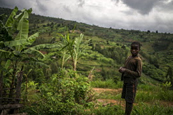FAO and its partners are involved in the development and implementation of digital inclusion initiatives and the scaling up of innovative digital services. Bringing solutions closer to the needs of poor households in Africa and other regions is a direct contribution to poverty reduction and food security. ICTs help maximizing the impact of existing rural advisory services, financial services, social protection programmes. ICTs facilitate access to markets, information and entrepreneurship opportunities. Digital inclusion initiatives address the barriers to mobile internet adoption through infrastructure and policy, affordability, digital literacy and availability of local content.
Mobile Apps for Local Content
This project focuses on the development of four apps that will help improving agricultural services and availability of local content. It will make useful data, information and statistics available and accessible as digital services to the rural poor.
The applications will be developed initially for use in two countries in Sub-Saharan Africa: Senegal and Rwanda. The apps and services can then be adapted for use in other countries as well. A particular emphasis will be put on needs of young, self-employed entrepreneurs, female headed households, breaking down the barriers for access and use of information through digital technologies. This project is part of a broader initiative that leverages the knowledge of FAO and its strategic partners in the mobile world, promoting digital inclusion for smallholders and family farmers.
| "Cure and Feed your livestock": An application providing real time information on animal diseases control and animal feeding strategies. The application will provide real time information and advice to livestock owners. The app will help reducing losses in assets and optimize productivity using locally available resources. In the same application, it will be possible to create groups of farmers that exchange information and learn from the experience of others and good practices in animal feeding, hygiene and disease prevention. |
| "e-Nutrifood": An application providing information on production, conservation and consumption of nutritious foods. Adequate information concerning the quality and combination of essential nutritional values of food are vital in fighting undernutrition, stunting and food insecurity. Inhabitants of rural areas do not receive enough good quality information and technical orientation to produce and consume adequately nutritious food. |
| "Weather and Crop calendar": An application combining information on weather forecasts and crop calendars. The mobile application provides early warning services to highlight potential risks and help increase resilience. Climate Risk Management has proven to help farmers “make informed decisions, better manage risk, take advantage of favourable climate conditions, and adapt to change”. |
| "AgriMarketplace": An application that will connect producers and traders to facilitate trade and access to prices. Farmers often do not have good sources of information about who are - and where are - the best providers of supplies for raw material purchases neither know the best marketplaces to sell their products and the market prices. |
Project Countries
 Rwanda 90% of the labour force is involved in agriculture (5.67 million people in agriculture) and an estimated half of rural households own livestock (the country counts 1.13 million heads of cattle, 3.5 million sheep and goats and 4.8 million chicken). Livestock is usually an important component of women livelihoods.
Rwanda 90% of the labour force is involved in agriculture (5.67 million people in agriculture) and an estimated half of rural households own livestock (the country counts 1.13 million heads of cattle, 3.5 million sheep and goats and 4.8 million chicken). Livestock is usually an important component of women livelihoods.
Providing they have a mobile phone and access to internet, the “Cure and Feed your livestock” app will be of use to over 2 million people working with livestock as owners or labourers. All of the 2.4 million households in Rwanda will potentially have access to the "e-Nutrifood", "AgriMarketplace" and "Weather and Crop calendar" apps.
The apps will be developed taking into account that 93% of the population speaks Kinyarwanda only and illiteracy rate is 30%, so special attention is given to voice services in the local language.
 Senegal The population of Senegal is 15.1 million. The median age is 19 and 62% of the population is below 24 years old. 55% of the population is rural and 47% of the population lives below the poverty line. 13% of children under the age of 5 years are underweight.
Senegal The population of Senegal is 15.1 million. The median age is 19 and 62% of the population is below 24 years old. 55% of the population is rural and 47% of the population lives below the poverty line. 13% of children under the age of 5 years are underweight.
77% of the labour force is involved in agriculture (5 million people in agriculture) and an estimated two thirds of rural households own livestock (the country counts 3.5 million heads of cattle, 11 million sheep and goats and 49 million chickens).
Providing they have a mobile phone and access to internet, the "Cure and Feed your livestock" app will be of use to an estimated 3 million people working with livestock as owners or laborers. All of the 1.5 million households in Senegal will potentially have access to the "e-Nutrifood", "AgriMarketplace" and "Weather and Crop calendar" apps.
The app will be developed taking into account distribution of languages in the country (Wolof 38.7%, Pular 26.5%, Serer 15%, Mandinka 4.2%) and a national illiteracy rate which is still at 40%, and higher in poor rural communities.






